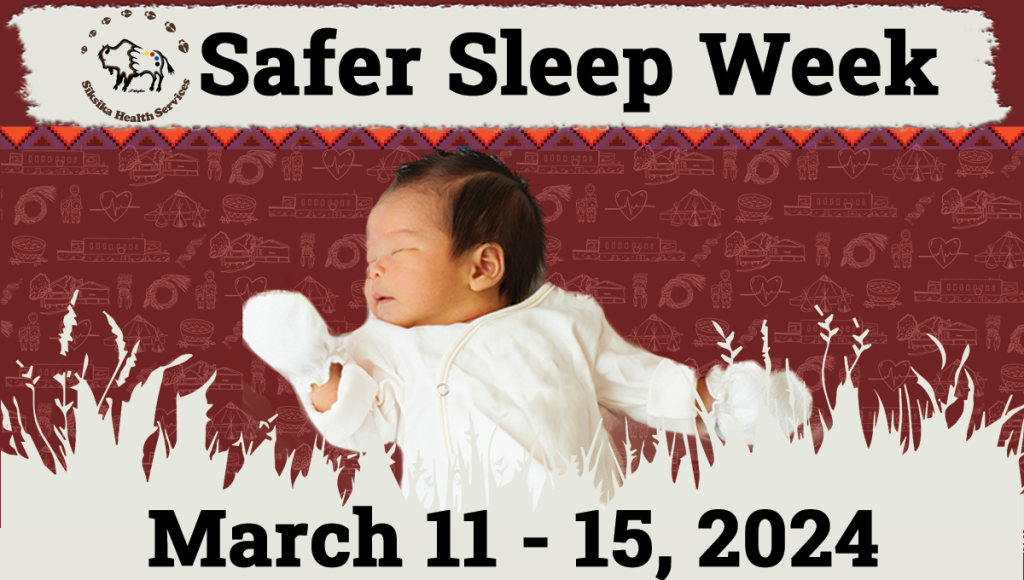
Safe Sleep for Babies

Siksika Health Services recognizes Safe Sleep Week from March 11-15, which promotes safe sleep practices for parents and caregivers of young infants.
Good sleep habits are important for your baby’s physical health and emotional well-being and creating a safe sleep environment for your baby will lower the risk of injury and sudden infant death syndrome (SIDS).
SIDS is when a baby (less than 1 year old), that seems healthy dies suddenly in their sleep, and the cause of death cannot be explained. We don’t know what causes SIDS, so it cannot be prevented, but there are things you can do to help lower the risk:
Smoke-Free
Being smoke-free, before and after birth, decreases your baby’s risk of SIDS. Smoking during pregnancy is one of the biggest risk factors for SIDS. One out of three SIDS deaths could be prevented if pregnant women did not smoke. Second-hand smoke also increases the risk of SIDS after your baby is born. Do not let anyone smoke around your baby – in the house, in the car or anywhere your baby spends time.
Breastfeeding
Breastfeeding lowers your baby’s risk of SIDS. There are lots of reasons to breastfeed. One important reason is that breastfeeding can help protect your baby from SIDS. The longer you can breastfeed, the more protection your baby will have. Exclusive breastfeeding is recommended for the first 6 months, and should continue after complementary foods start.
Bedding
The safest place for your baby to sleep or nap is in a crib, cradle or bassinet that meets current Canadian safety regulations. A safe infant sleep surface has:
- A firm, flat mattress with a tightly fitted sheet
- No gaps between the mattress and sides
- No loose, soft items – including blankets, pillows, bumper pads etc.
Not recommended for sleep:
- Bed-side sleepers that attach to an adult bed are not recommended.
- Baby nests or pods (small, portable pads with soft, padded sides) and other soft products like nursing pillows are not recommended for sleep.
- Products with a sleep surface that is not flat, like inclined sleepers, baby hammocks and crib wedges, should not be used – even for babies who spit up a lot.
- High chairs, baby swings, bouncers, strollers and car seats are made for babies, but not for sleep. If your baby falls asleep in a high chair, bouncer or swing, be sure to move them to a crib, cradle or bassinet. If your baby falls asleep while travelling in a car seat or stroller, move your baby to a crib, cradle or bassinet when you arrive at your destination.
- Sofas or arm chairs, air mattresses and adult beds are not made for babies to sleep on.
Overheating increases your baby’s risk of SIDS
- Your baby is safest when they sleep in simple, fitted sleepwear – like a sleeper.
- Keep the room at a comfortable temperature.
- Babies do not need a hat when indoors, as it can make them too hot.
- Babies do not need blankets when they sleep.
Room sharing
Room sharing means placing your baby to sleep in their own safe sleep space – a crib, cradle or bassinet – which is placed in your room next to your bed. Room sharing is recommended for your baby’s first 6 months – the time when the risk of SIDS is the highest.
Bed sharing is when a baby sleeps with an adult or other child on the same sleep surface, such as an adult bed, sofa or armchair. Bed sharing increases a baby’s risk of SIDS and suffocation.
Some parents end up bed sharing with their baby, even though they do not plan to. It is important to understand the risks and know the situations that make bed sharing especially unsafe for babies, so you can take steps to avoid them. These situations put babies at especially high risk when bed sharing:
- The baby is less than 4 months old or was born preterm or with low birthweight
- The person bed sharing with the baby has taken alcohol or drugs
- The person bed sharing with the baby has taken medication that makes them tired or harder to wake up
- The baby’s mother smoked during pregnancy, or the person bed sharing with the baby is a smoker, or if there is smoking in the household
- The sleep surface is soft – sleeping with a baby on a sofa, armchair, air mattress, waterbed or bed with a mattress topper is very unsafe
- There is more than one other person (or a pet) bed sharing with the baby
- There is loose bedding, pillows, blankets and other objects near the baby
Parents and all caregivers – including grandparents, family members, childcare providers, babysitters and friends – can help keep babies safe by following the steps for safe sleep for every sleep – nap time and nighttime, at home, in childcare settings and when travelling.
